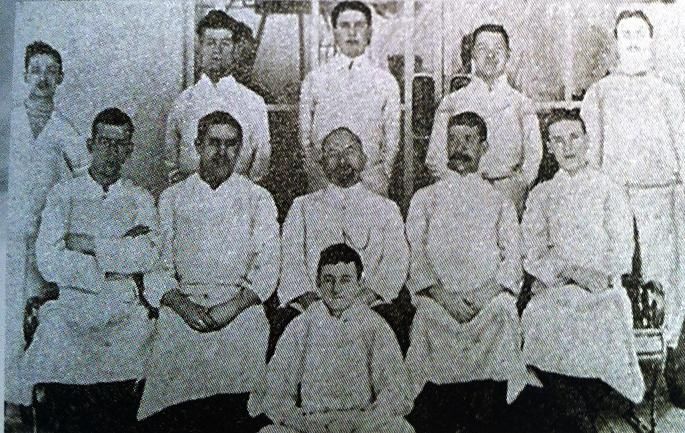The cooks and other support staff of the Titanic “drowned like rats” due to not being assigned a clear place in the pecking order of escapees. One who did survive was French cook Paul Mauge, who used his extraordinary wits to survive. This episode chronicles how cooks like Mauge arrived on the Titanic, how they survived (or didn’t), and what it was like for the service personnel on the night the ship went down.
Paul Maugé:
- Unlike many of his shipmates, the Titanic was his first experience working at sea.
- Paul provided testimony during the British inquiry into the sinking of the Titanic. He was the assistant to Pierre Rousseau, the chef of the Titanic’s à la carte restaurant Because the à la carte restaurant was not operated by the White Star Line but by Luigi Gatti as a concession, its chefs were not considered part of the Titanic crew, but they also were not passengers—which led to confusion in the line of succession when filling lifeboats. They clung together near their quarters, which were on E Deck aft.
- As a member of Gatti’s concessionaire staff, Paul and the other à la carte staff members were not assigned lifeboat or evacuation duties like many of the Titanic crew members. Some six weeks later, on June 7, a wire service headline would announce to the world, “Titanic cooks drowned like rats.” A reporter covering the investigation underway in London wrote: “Sixty kitchen employees aboard the Titanic drowned like rats in a trap when the liner went down because stewards blocked their way when they attempted to go to the decks, according to Paul Mauge, secretary to the chef of the sunken liner who to-day was a witness in the Board of Trade’s Titanic inquiry.”
- They tried to go onto the second class passenger deck, but two or three stewards on each side of it would not let them go. They were wearing plainclothes & looked like passengers so they were allowed onto the boat deck.
He saw a lifeboat being lowered between two decks and jumped directly from the top deck to the lifeboat—about ten feet down. About six or ten people jumped into it, including journalist Lawrence Beesley. It was Lifeboat 13. Paul hollered for Chef Rousseau to jump into the lifeboat, too. “Sautez! Sautez! (Jump! Jump!)” But Rousseau called back that he could not jump because of his robust size. Paul could not hear chef’s response because at the same time a crew member yelled at him: “Shut up!” and grabbed him by the back of his coat to try to pull him out of his seat. Paul wriggled out of the man’s grasp and secured his seat. He survived, but Chef Rousseau did not.
Adolf Mattmann: The Ice Cream Maker (“The Ice Man”)
- Adolf Mattman managed the ice cream treats and frozen sweets in the luxurious à la carte restaurant in first class. “Ice Man” was his official job title on the crew list.
Exceptional experience even in a crew cherry-picked for prestigious duty aboard the Titanic. Mattmann had apprenticed as a pastry chef in Freiburg, Switzerland, and worked for a time at the storied Karl Häberle pastry shop in Lucerne. Mattmann dreamt of employment in one of London’s luxury hotels after working a few crossings aboard the Titanic
- Mattmann boarded as crew in Southampton on April 10. The first reports of the sinking appeared in Switzerland on April 17 in papers such as the Lucerne Tagblatt.
The first stories were contradictory, and everyone waited with hope that their hometown hero was safe. Near the end of the month the White Star Line notified the Mattmanns that Adolf had been on board the Titanic and had not been rescued. On April 30, the village of Inwil had a funeral service for Adolf.
Recipe Spotlight:
4 cups milk 1½ cup cream 2½ cup sugar 1 cup dry milk powder 10 egg yolks 1 Tablespoon salt 2 vanilla pods with seeds scraped
Heat milk, cream, and vanilla beans, with spent pods added, to simmer. Combine sugar and egg yolks together. Once up to a simmer, add milk powder. Pour about 2 cups of milk mixture over eggs and sugar and whisk until tempered, then add back to the pot. Cook and whisk until milk coats the back of a spoon. Cool immediately by placing the pot in an ice bath. When mixture is cool, strain through a fine mesh strainer to get the vanilla pods and any lumps out. Let base mature overnight, then process in your ice cream machine.
—Michael Elliott, Hearth Restaurant, Evanston, Illinois
About the Producers of the Series
Veronica Hinke is an expert in Food History & Culinary Narrative. She is the author of the acclaimed historical novel “The Last Night on the Titanic: Unsinkable Drinking, Dining & Style).” Veronica is passionate about sharing her love of history, culinary arts and most of all…. people. “Every food story I’ve ever written, always, at the core of each one, ended up being about the people, and that doesn’t seem to change. My book, “The Last Night on The Titanic,” is no different. Those stories of hope and resilience…I think that’s why the Titanic story is still alive today.”
Veronica’s mouthwatering books, short stories and magazine articles explore food history and the delicious culinary narratives that take you back in time. My heart calling is writing, teaching and speaking about the art of storytelling.
Scott Michael Rank, Ph.D., is the editor of History on the Net and host of the History Unplugged podcast. A historian of the Ottoman Empire and modern Turkey, he is a publisher of popular history, a podcaster, and online course creator.
Cite This Article
"Last Night on the Titanic: The Cooks" History on the Net© 2000-2024, Salem Media.
July 25, 2024 <https://www.historyonthenet.com/last-night-titanic-cooks>
More Citation Information.

